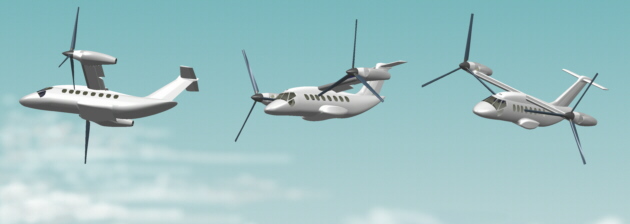RHILP - Rotorcraft Handling Interactions and Loads Prediction
In March 2000, the first in a series of EU funded (Framework V) programmes, RHILP, was launched to reduce the risk for the critical technologies in the development of a future civil tilt rotor aircraft (CTR) using flight dynamics computer modelling. The proposed aircraft was due to be built in 2008 with an in-service date of 2013.
RHILP Project goals:
-
establish handling qualities (HQ) criteria for the aircraft
-
develop a core stability and control augmentation system
-
improve modelling and handling of low speed aerodynamic interactions
-
define the options for the active control of structural load alleviation
A tilt rotor aircraft has three modes of flight: airplane mode, in which the rotors are tilted forward; helicopter mode, in which the rotors are vertically aligned and conversion mode, in which the rotors are partially tilted. One of the main issues in designing such an aircraft is to examine the way in which the handling of the aircraft (handling qualities) is influenced by its mode of operation.
With Eurocopter as the project leader the team included DLR, NLR, CIRA, ONERA and The University of Liverpool. During the first year the team constructed a methodology and criteria set that would be usable across helicopter, conversion and airplane flight modes. As expected, this analysis identified several compatibility issues between helicopter and airplane mode HQ criteria and also HQ gaps, particularly relating to the conversion mode.
As a result, a series of piloted simulations are being conducted on the HELIFLIGHT facility at Liverpool’s Flight Simulation Lab (FSL) to develop a better understanding of these issues and to narrow the gaps. Liverpool are involved in two work packages, Work Package 1 Specification of Handling Qualities Criteria and Work Package 3 Structural Load Alleviation
Liverpool have developed a FLIGHTLAB model of the Bell XV-15 aircraft based on published data which will be used to validate and build confidence in the modelling and simulation activity before transfer to the Eurocopter CTR configuration EUROTILT. During summer 2001 a simulation trial was conducted at the FSL supported by a CAA test pilot, a DGA test pilot and a former Royal Navy test pilot. These HELIFLIGHT CTR simulations are providing a unique database of handling qualities from which criteria can be further developed in the continuing RHILP programme and a future ACS can be designed.

Artist’s Impression of the Eurocopter
EUROTILT CTR Configuration